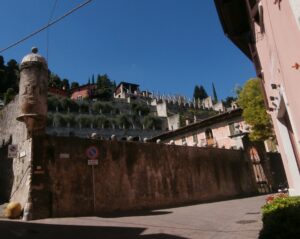Disclaimer 1: I married into the family of the book’s subject, Aelfrida Tillyard (1883-1959). My parents-in-law get a fleeting mention towards the end. As I have this personal connexion, the following observations will focus on those aspects of Aelfrida’s life which have overlapped with my own.
Disclaimer 2: Long before I met any of her other relatives, I must have rubbed shoulders with Aelfrida’s daughter Alethea, as for a few months we attended the same church (St Andrew’s, Old Headington). However, I don’t remember her. I don’t really remember much about the church in those days except its general appearance inside (its character has now been drastically changed by re-ordering and I suspect Alethea would barely recognise it), the over-powerful organ (once Merton College’s, since replaced) and for being the only church I’ve come across which used the BBC Hymn Book.
This is described as a ‘novel biography’ though it does not stray far beyond demonstrable fact. Aelfrida’s life is amply documented, though sometimes not enough for the author: ‘what would one not give for a diary account of [Aelfrida’s meeting with my future parents-in-law after their marriage]’.
After a fairly conventional Cambridge academic childhood (with faint Bloomsbury connections) such as is described in many memoirs and biographies, Aelfrida embarked on a doomed marriage with a half-Greek diplomat. Throughout her life she had a mystical bent; in her youth this led to an involvement with Aleister Crowley, but after a family tragedy she gravitated into the Church of England.
She had an ascetic trait I recognise as a family characteristic, but which in her case expressed itself through religion. At one point she joined a lay community, a form of spiritual life which has now fallen completely out of fashion. Why should it have done so? Perhaps it is because there is now a much greater range of opportunities for women, but maybe also because the degree of self-sacrifice it requires is too much for people these days. There are of course still experiments in communal living, but now they tend to be ecological rather than religious in inspiration. And while there will always be Christian mystics, it is now possible and indeed quite common to have spirituality without being attached to any particular religious group or sect.
I skipped on to what really interested me, Anglo-Catholicism in mid-20th century Cambridge. How did it differ from when I came into this wing of the church in the same place some decades later?
Aelfrida’s route was different from mine, as she didn’t have much to do with the church I joined, Little St Mary’s, attaching herself to St Botolph’s. I sang at the wedding of a friend there, and sang a service or two there with the Chapel choir of my college, Corpus. The choir had a rather chilly welcome, because at that time it was believed in the congregation that Corpus wanted to have St Botolph’s shut down and made into its library extension, and that the choir was presumably being sent round to case the joint. An attempt to visit with the choir of Little St Mary’s was refused by the then Rector. Maybe they just didn’t like guest choirs at St Botolph’s? It always struck me as middle-of-the-road, 1662-friendly Anglicanism, rather than High Church.
I could have done with a family tree (perhaps somewhere in the 1006 pages I missed one) not least to help distinguish the various women in the family whose names begin and end in A: Aelfrida herself, Agatha, Alicia, Alethea, Anatolia and Agneta (not Angela, whom I see quite regularly).

